Come viene letta la Bibbia, cioè cosa viene istituzionalmente proposto come lettura liturgica da ogni singola tradizione confessionale o cosa viene assorbito della Bibbia dai lettori più autorevoli di ogni tradizione confessionale e riemerge nei loro scritti spirituali od omiletici – questo vuole indagare la presente serie di studi accomunata dal titolo generale di Usi della Bibbia.
How the Bible is read, i.e. what is proposed as an institutional liturgical reading by every single denomination or what is absorbed by the most influential readers of the Bible of every denomination and re-emerges in their of spiritual or homiletic writings – this will be investigated by this series of studies united by the general heading Usi della Bibbia.
F. Mora, Uses of the Bible: a starting point, Charleston 2015, pp. 304, ISBN 9781508732495 (buy)
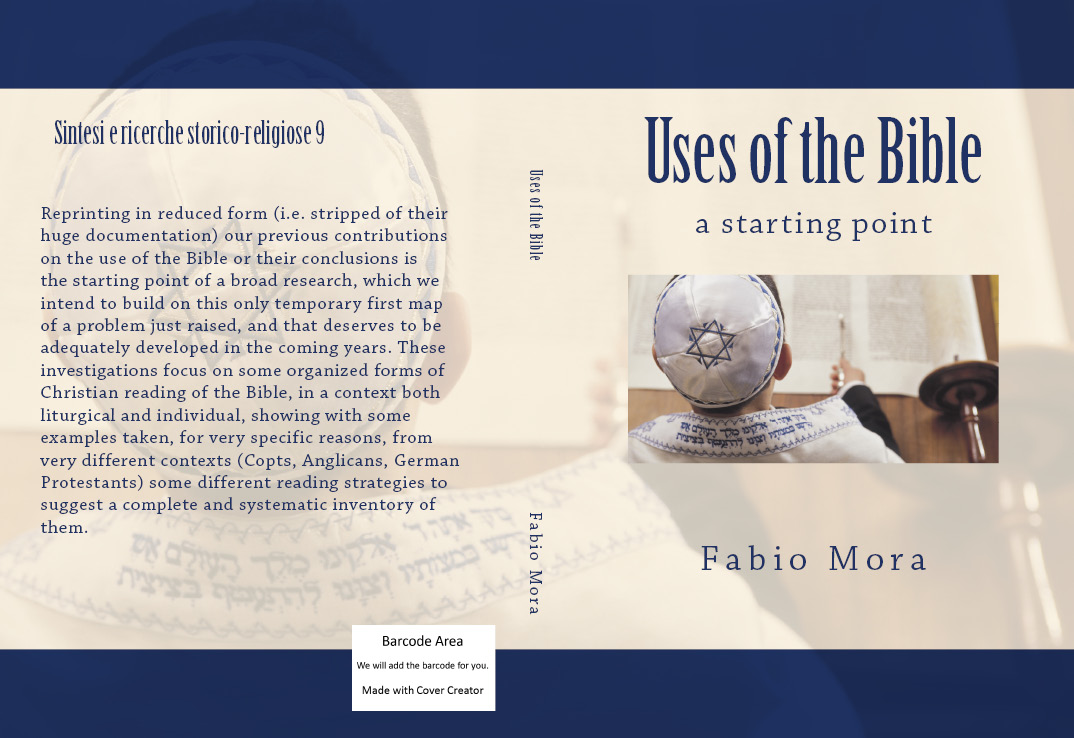
English translation of Usi della Bibbia: una prima sintesi, the following work.
Reprinting in reduced form (i.e. stripped of their huge documentation) our previous contributions on the use of the Bible or their conclusions is placed rather at the beginning of a broader research, which we intend to build on this only temporary first map of a problem just raised, and that deserves to be adequately developed in the coming years. These investigations focus on some organized forms of Christian reading of the Bible, in a context both liturgical and individual, showing with some examples taken, for very specific reasons, from very different contexts (Copts, Anglicans, German Protestants) some different reading strategies to suggest a complete and systematic inventory of these strategies. This inventory should naturally be extended to a post hoc analysis of the liturgical free reading, used by the churches of the Reformation without lectionary and other forms of organized transmission of the sacred text, from the breviary to its use in Sunday schools. To make investigations on Christian use of the Old Testament particularly productive is the complex and unknowingly varied relationship that Christians have with the text of another religion, which they can neither fully keep nor completely abandon - and often appear to estimate more in theory than in actual practice. The composite character of the Ancient (as well as the New) Testament makes more relevant the process of anthologizing different works that inevitably accompanies every incomplete reading. But the question of the real use of the sacred text concerns also the relationship of the Jews with their own Bible, with Tanakh’s three parts (Torah, Nevi'im, Ketuvim) of degrading sanctity and authority, and between Torah/Tanakh and the Talmud, as well as their selective anthologizing Nevi'im and their reading of Megillot or, in another context, the Zionist return to the Tanakh and the Karaite reading of the entire biblical text. Without going for now in the complex and interesting comparative questions about the use of the sacred text in other religions, we have decided to raise the issue of the very different relationship with his third, further sacred text entertained both by the main Mormon Church, the Church of Jesus Christ of latter-day Saints in Utah, and the small community still tied to the family of its founder, now called Community of Christ, where a continuous prophetic revelation has not yet ended.
F. Mora, Usi della Bibbia: una prima sintesi, Charleston 2013, pp. 318, ISBN 9781499291868 (buy)
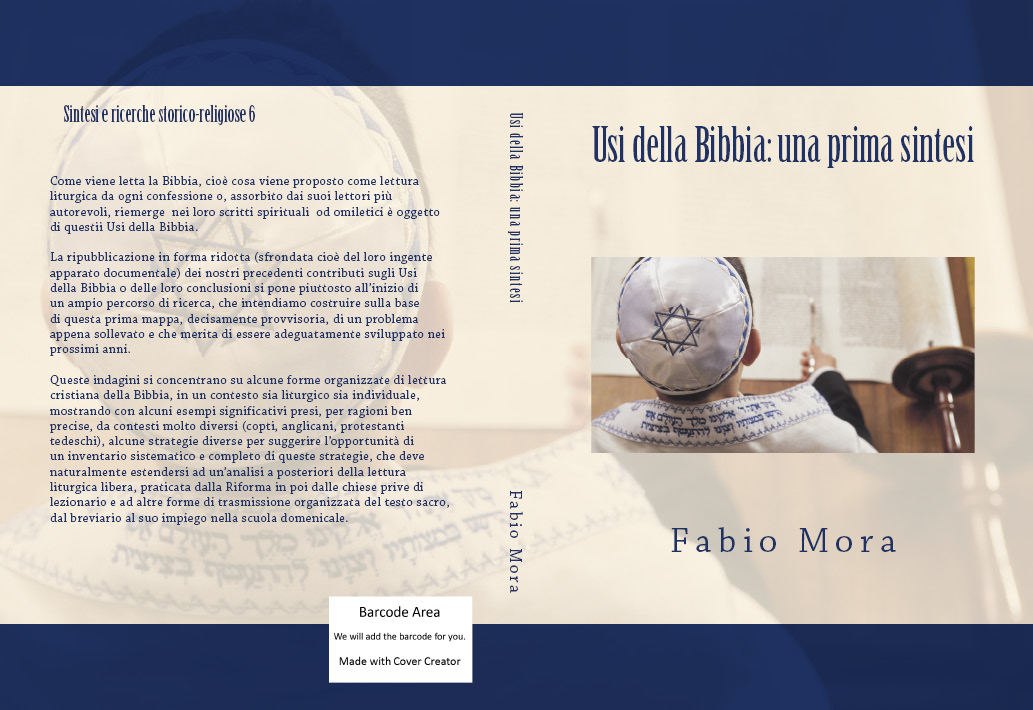
La ripubblicazione in forma ridotta (sfrondata cioè del loro ingente apparato documentale) dei nostri precedenti contributi sugli Usi della Bibbia o delle loro conclusioni si pone piuttosto all’inizio di un ampio percorso di ricerca, che intendiamo costruire sulla base di questa prima mappa, decisamente provvisoria, di un problema appena sollevato e che merita di essere adeguatamente sviluppato nei prossimi anni.
Le presenti indagini si concentrano su alcune forme organizzate di lettura cristiana della Bibbia, in un contesto sia liturgico sia individuale, mostrando con alcuni esempi significativi presi, per ragioni ben precise, da contesti molto diversi (copti, anglicani, protestanti tedeschi) alcune strategie diverse per suggerire l’opportunità di un inventario sistematico e completo di queste strategie, che deve naturalmente estendersi ad un’analisi a posteriori della lettura liturgica libera, praticata dalla Riforma in poi dalle chiese prive di lezionario e ad altre forme di trasmissione organizzata del testo sacro, dal breviario al suo impiego nella scuola domenicale.
A rendere particolarmente produttive le indagini sull’Antico Testamento è il complesso, e inconsapevolmente variegato, rapporto che i cristiani hanno con un testo di altra religione, che non possono né pienamente conservare né completamente abbandonare – ed appaiono spesso stimare più in teoria che nell’effettiva pratica. Il carattere composito dell’Antico (come pure del Nuovo) Testamento rende più rilevante il processo di antologizzazione da opere diverse che accompagna inevitabilmente ogni lettura non integrale. Ma la questione degli effettivi usi del testo sacro riguarda anche il rapporto degli ebrei con la propria Bibbia, con le tre parti (Torah, Neviim, Ketuvim) di degradante sacralità ed autorità di Tanak, tra queste ed il Talmud, la loro antologizzazione selettiva dei Neviim (che accanto ai Profeti posteriori, o Profeti tout court per i cristiani, che loro aggiungono Daniele, comprendono anche la storiografia deuteronomistica dei Profeti anteriori) o la loro lettura delle Megillot, il ritorno sionista a Tanak, la lettura caraita dell’intero testo biblico.
Senza entrare per il momento nelle complesse ed interessanti questioni comparative sull'uso del testo sacro nelle altre religioni, abbiamo ritenuto opportuno sollevare la questione del rapporto, molto diverso, che col proprio terzo, ulteriore testo sacro intrattengono la principale chiesa mormone, la Chiesa di Gesù Cristo dei santi degli ultimi giorni dello Utah, e la piccola comunità ancora legata alla famiglia del suo fondatore, oggi denominata Community of Christ, per cui la rivelazione profetica non si è ancora conclusa.
Per la traduzione inglese vedi l'opera precedente. For an English translation see the preceding work, Uses of the Bible: a starting point
F. Mora, Uses of the Bible VI Anglican lectionaries 1549-1949, Charleston 2015, pp. 264, ISBN 9781508732846 (buy)
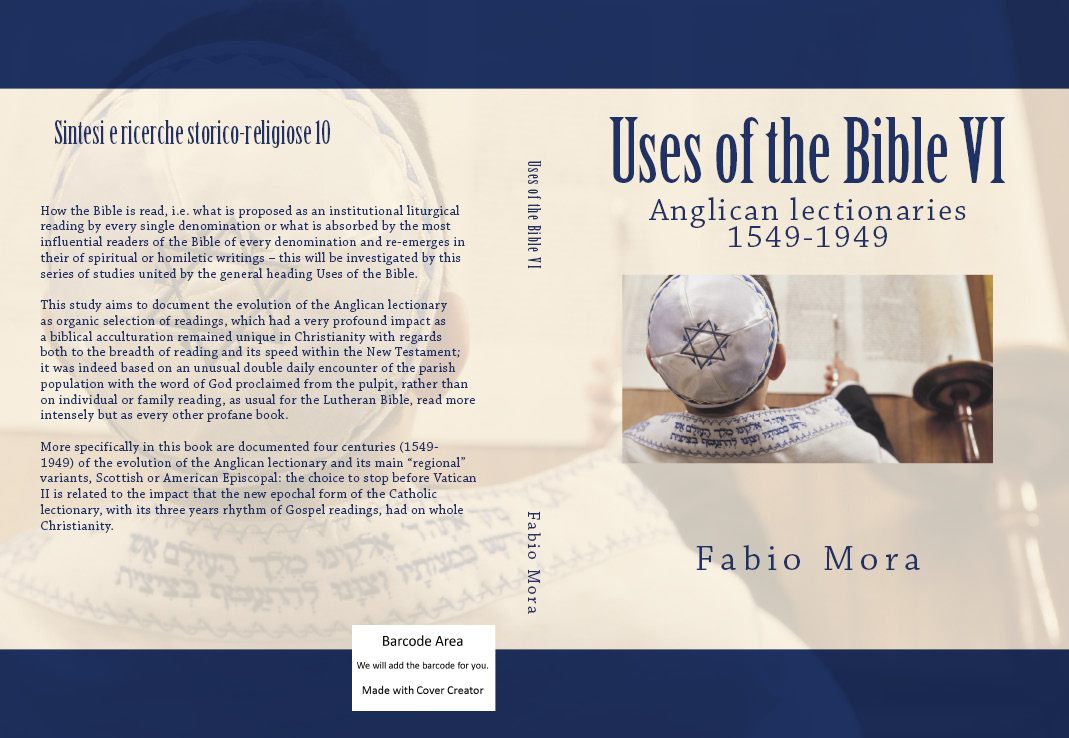
English translation of Usi della Bibbia VI Lezionari anglicani 1549-1949, the following work.
This study aims to document the evolution of the Anglican lectionary as organic selection of readings, which had a very profound impact as a biblical acculturation remained unique in Christianity with regards both to the breadth of reading and its speed within the New Testament; it was indeed based on an unusual double daily encounter of the parish population with the word of God proclaimed from the pulpit, rather than on individual or family reading, as usual for the Lutheran Bible, read more intensely but as every other profane book.
More specifically in this book are documented four centuries (1549-1949) of the evolution of the Anglican lectionary and its main “regional” variants, Scottish or American Episcopal: the choice to stop before Vatican II is related to the impact that the new epochal form of the Catholic lectionary, with its three years rhythm of Gospel readings, had on whole Christianity.
F. Mora, Usi della Bibbia VI Lezionari anglicani 1549-1949, Messina 2013, pp. 308, ISBN 9788890622267 (buy)
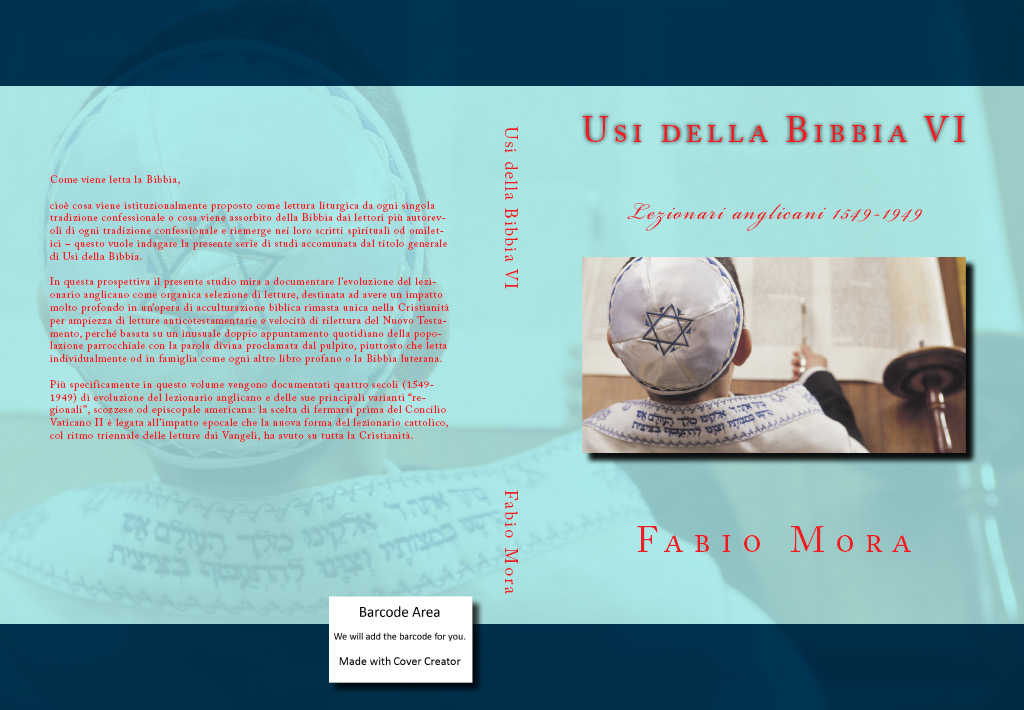
Questo studio mira a documentare l’evoluzione del lezionario anglicano come organica selezione di letture, destinata ad avere un impatto molto profondo in un’opera di acculturazione biblica rimasta unica nella Cristianità per ampiezza di letture anticotestamentarie e velocità di rilettura del Nuovo Testamento, perché basata su un inusuale doppio appuntamento quotidiano della popolazione parrocchiale con la parola divina proclamata dal pulpito, piuttosto che letta individualmente od in famiglia come ogni altro libro profano o la Bibbia luterana.
Più specificamente in questo volume vengono documentati quattro secoli (1549-1949) di evoluzione del lezionario anglicano e delle sue principali varianti “regionali”, scozzese od episcopale americana: la scelta di fermarsi prima del Concilio Vaticano II è legata all’impatto epocale che la nuova forma del lezionario cattolico, col ritmo triennale delle letture dai Vangeli, ha avuto su tutta la Cristianità.
Per la traduzione inglese vedi l'opera precedente. For an English translation see the preceding work, Uses of the Bible VI Anglican lectionaries 1549-1949
F. Mora, Usi della Bibbia V Die taeglichen Losungen dei fratelli moravi, Messina 2012, pp. 282, ISBN 978-8890622243 (buy)
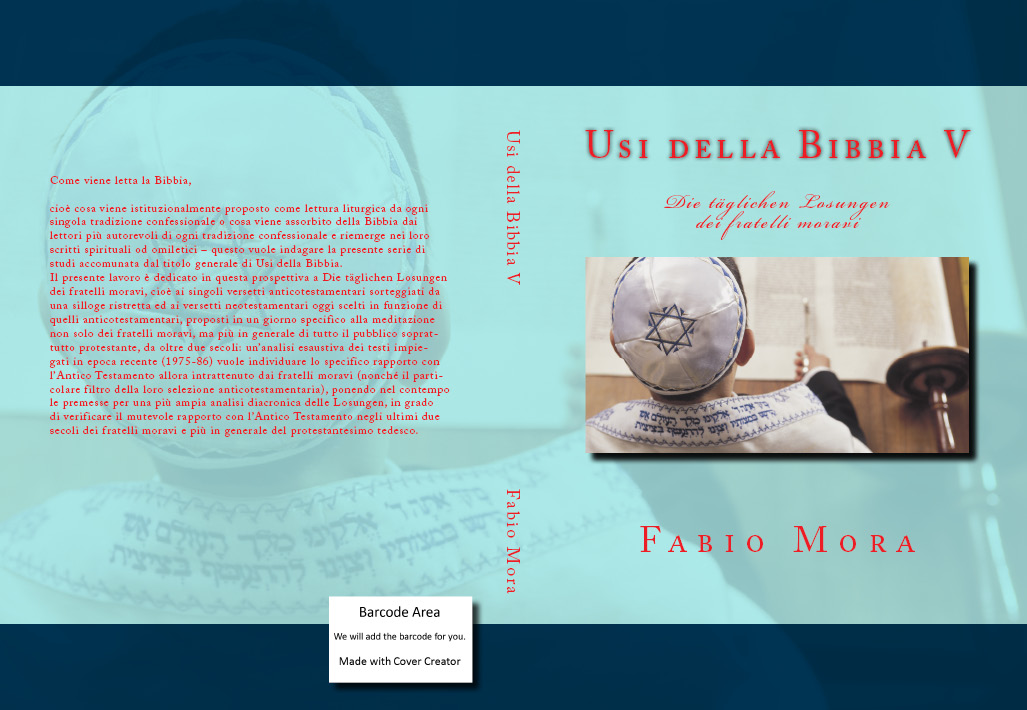
Questo lavoro è dedicato a Die täglichen Losungen dei fratelli moravi, cioè ai singoli versetti anticotestamentari sorteggiati da una silloge ristretta ed ai versetti neotestamentari oggi scelti in funzione di quelli anticotestamentari, proposti in un giorno specifico alla meditazione non solo dei fratelli moravi, ma più in generale di tutto il pubblico soprattutto protestante, da oltre due secoli: un’analisi esaustiva dei testi impiegati in epoca recente (1975-86) vuole individuare lo specifico rapporto con l’Antico Testamento allora intrattenuto dai fratelli moravi (nonché il particolare filtro della loro selezione anticotestamentaria), ponendo nel contempo le premesse per una più ampia analisi diacronica delle Losungen, in grado di verificare il mutevole rapporto con l’Antico Testamento negli ultimi due secoli dei fratelli moravi e più in generale del protestantesimo tedesco.
This study is dedicated to Die täglichen Losungen of the Moravian Brethren, i.e. the individual verses drawn from a restricted compilation of verses from the Old Testament and the verses from the New Testament selected to match them, that for over two centuries have been proposed day for day to the meditation not only of the Moravian Brethren but more generally to a wider, Protestant audience.
A comprehensive analysis of the texts used in recent times (1975-86) seeks to identify the specific relationship with the Old Testament then entertained by the Moravian Brethren (and the particular filter dominating their selection of Old Testament), while laying the foundation for a broader, diachronic analysis of the Losungen, aiming to check the changing relationship with the Old Testament in the last two centuries of the Moravian Brethren, and more generally of German Protestantism.
F. Mora, Uses of the Bible I: the Bibellese der Oekumenischen Arbeitsgemeinschaft, Charleston 2015, pp. 146, ISBN 9781508732891 (buy)
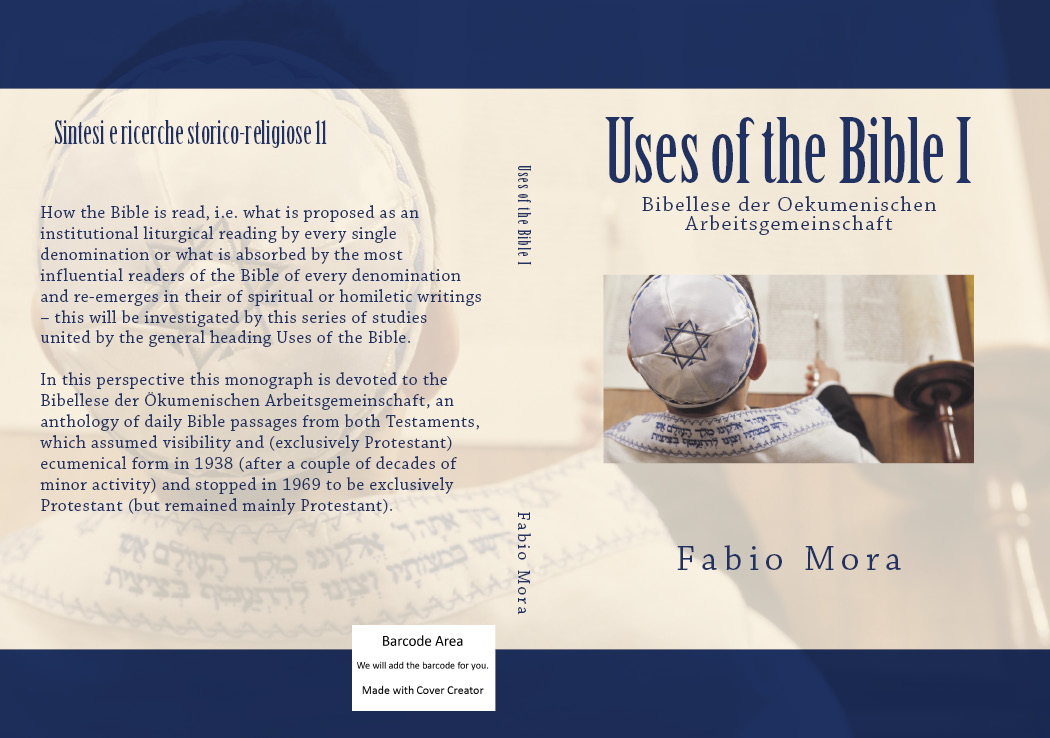
English translation of Usi della Bibbia La Bibellese der Oekumenischen Arbeitsgemeinschaft, the following work.
This monograph is devoted to the Bibellese der Ökumenischen Arbeitsgemeinschaft, an anthology of daily Bible passages from both Testaments, which assumed visibility and (exclusively Protestant) ecumenical form in 1938 (after a couple of decades of minor activity) and stopped in 1969 to be exclusively Protestant (but remained mainly Protestant).
F. Mora, Usi della Bibbia La Bibellese der Oekumenischen Arbeitsgemeinschaft, Messina 2011, pp. 150, ISBN 9788882680282 (buy)
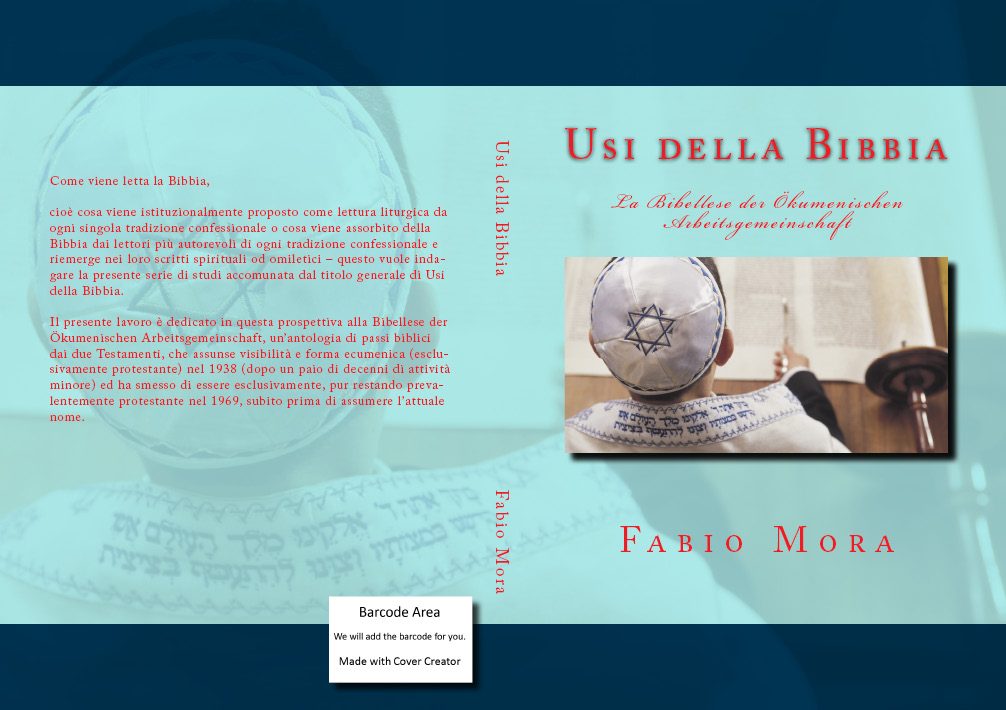
This monograph is devoted to the Bibellese der Ökumenischen Arbeitsgemeinschaft, an anthology of daily Bible passages from both Testaments, which assumed visibility and (exclusively Protestant) ecumenical form in 1938 (after a couple of decades of minor activity) and stopped in 1969 to be exclusively Protestant (but remained mainly Protestant).
Per la traduzione inglese vedi l'opera precedente. For an English translation see the preceding work, Uses of the Bible I: the Bibellese der Oekumenischen Arbeitsgemeinschaft.
The same numbering was used also for individual papers in Polifemo:
F. Mora, Usi della Bibbia VIII Il Nuovo Testamento nel lezionario copto , Polifemo 14, 2014, 179-202
F. Mora, Usi della Bibbia VII L'Antico Testamento nel lezionario copto, Polifemo 14, 2014, 167-178
F. Mora, Usi della Bibbia IV. Un nuovo lezionario luterano?, Polifemo 11, 2011, 431-453
F. Mora, Usi della Bibbia III. Piani di lettura, Polifemo 11, 2011, 253-276
F. Mora, Usi della Bibbia II. Il lezionario copto, Polifemo 11, 2011, 153-208